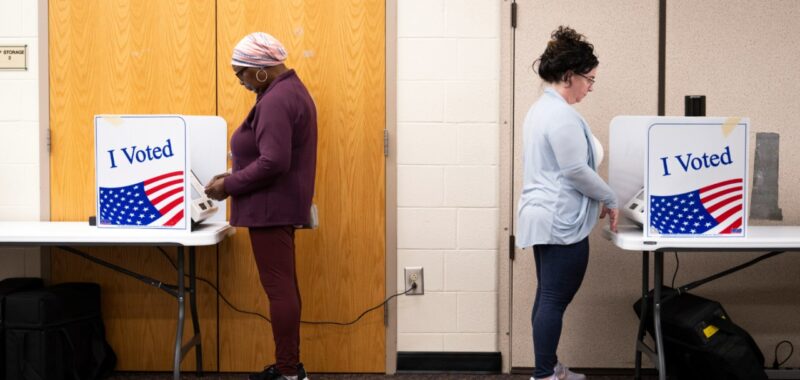
Fortunately for both Biden and Trump, November won’t be a popularity contest. Biden is the more fortunate of the two, but only slightly so.
According to Real Clear Politics average of national polling, Biden trails Trump 44.2 percent to 44.5 percent in a two-way rematch, while his unfavorable rating is 55.1 percent to Trump’s 53.7 percent. In such adverse circumstances, November will be about getting supporters to the polls: Here Biden’s disadvantage looms larger still.
The current presidential rematch appears close, as neither Biden nor Trump seem to be able to pull far ahead. Over the last year, Trump’s largest lead has been 4.3 percentage points on Jan. 26. The two were last tied on Oct. 19, at 43.9 percent apiece. And Biden’s last lead was by 0.2 percentage points on Sept. 11, while his biggest lead was 2 percentage points on Aug. 23.
Today’s tightness is a far cry from four years ago. Then Biden appeared to be comfortably leading throughout. As late as Oct. 11, 2020, Biden’s lead in Real Clear Politics’ average national polling was 10.3 percent — not far below his Sept. 18, 2019, highpoint of an 11.8 percentage-point advantage.
Undoubtedly, Biden has closed in the polls recently, even as he is still substantially off from the leads he enjoyed historically. In a race so peculiar and with such dichotomies, to understand it we must look closely.
One telling element that is only starting to emerge is the divergence between polls of registered and likely voters. This difference is only starting to emerge because pollsters are only now beginning to differentiate between the two potential voting groups: those eligible to vote and those indicating a greater inclination to vote.
The Real Clear Politics national polling average lumps registered and likely voter polls together. But when averaged separately, a distinct divergence emerges.
Using the eight registered voter polls that Real Clear Politics used on Monday, Biden leads Trump by 0.5 percentage points — 44 percent to 43.5 percent — in a two-way race. Biden also leads in the five polls tracking a five-way race: 40.8 percent to 40.2 percent.
However, the situation is very different in a likely voter poll average. In the three likely voter polls of a two-way race, Trump leads 47.3 percent to 44.7 percent. In the four polls of a five-way race, Trump’s lead grows to 43.7 percent to 40 percent.
In so close a race, such a relatively large dichotomy is noteworthy.
Biden has an ample history of low support. In his 1988 and 2008 runs for the Democratic nomination, he fared poorly, never becoming a serious contender. In 2016, despite being vice president, he was passed over by Obama for Hillary Clinton. These would not have happened if Biden had had significant support.
Even when he was seemingly the clear frontrunner and the Democratic establishment’s standard bearer, he nearly failed. His campaign was saved from its two predecessors’ ignominy by his performance in South Carolina’s primary. Even with the nomination sewed up, his support was lackluster among Democrats: In the last Real Clear Politics poll of the Democratic contest, Biden held only a 60.8 percent to 32 percent advantage over Sen. Bernie Sanders (I-Vt.).
The same slide in support occurred in the general election. Even though he had held double-digit leads over Trump at many points in the contest — including less than one month from Election Day — Biden won by 4.5 percent of the popular vote and only a few tens of thousands of votes gave him the win in the six battleground states he needed to secure electoral vote victory. Today in a five-way race among likely voters, Biden is polling almost 11 percentage points below his 2020 popular vote percentage.
Biden may continue to improve in the polls. Incumbency has its advantages and Biden’s administration appears intent on using these to the fullest. And Trump is clearly divisive. Biden’s reported cash advantage will likely help his poll numbers as well — we may already be seeing its evidence.
Yet Biden has three problems: public popularity and supporter loyalty. Historically, Biden has never had the former and therefore has not reaped the latter. Biden’s other problem is that he’s running against someone whose supporters appear very committed. To appreciate that impact, look back to 2020.
In Real Clear Politics’ last national polling average before the election, Biden led Trump 51.2 percent to 44 percent. In the election, Biden’s popular vote percentage edged up just 0.2 percentage points to 51.4 percent; in contrast, Trump’s moved up 2.9 percentage points. Biden’s actual popular vote margin was not half his polling margin less than one month earlier. Today, Trump’s support among likely voters is ahead of his 2020 final popular vote percentage (47.3 percent vs. 46.9 percent).
As the oddity that is the 2024 election continues to unfold, polling warrants extra scrutiny. Never has it been truer: It’s not the polls that count, but who is counted at the polls.
Biden has historically struggled here, while Trump has overperformed. We see evidence of this again in today’s split between registered and likely voter polling.
J.T. Young was a professional staffer in the House and Senate from 1987-2000, served in the Department of Treasury and Office of Management and Budget from 2001-2004, and was director of government relations for a Fortune 20 company from 2004-2023.
Copyright 2024 Nexstar Media Inc. All rights reserved. This material may not be published, broadcast, rewritten, or redistributed.

